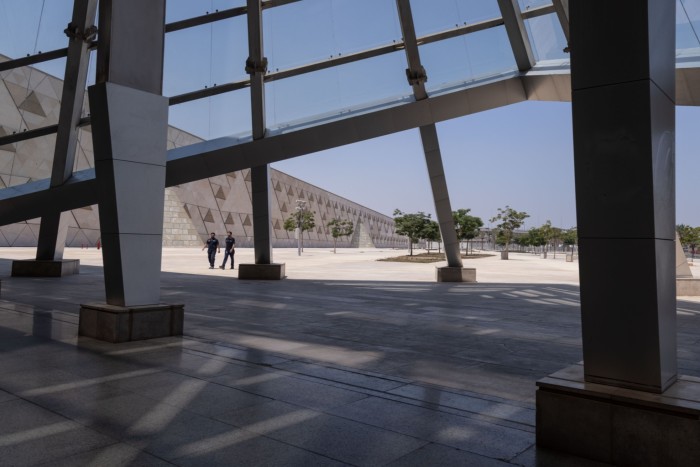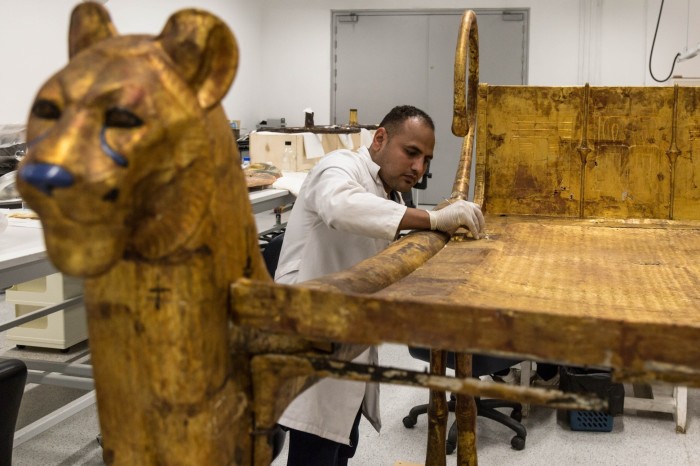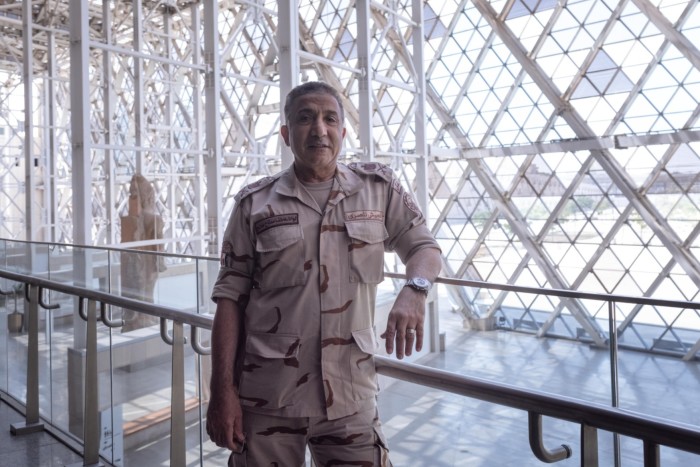Colossal statues of pharaohs on granite thrones adorn the great staircase at the Cairo’s new Grand Egyptian Museum, while a steel atrium soars above the building, engineered to draw in cooler air currents to ease the desert heat.
The vast complex, which is sited close to the pyramids plateau in Giza, is nearing completion and almost ready for its launch scheduled for next year — almost 20 years after construction began.
Cairo has vaunted the GEM as the largest museum in the world devoted to a single civilisation and is counting on the $1.2bn project to boost the country’s crucial tourism industry.
Egyptologists and archeologists also hope that with its 100,000 pharaonic and predynastic artefacts, modern conservation laboratories and research facilities, the museum will serve as a centre for international scholarship.
“Like any good museum, the GEM will tell a story,” said Ahmed Issa, minister of tourism and antiquities. “This will be about how 30 dynasties over a few thousand years created one of the earliest states in history.”

The museum complex features 12 galleries, covering the periods from prehistoric times until the end of the Roman era in Egypt. Pride of place will be given to the treasures found in the tomb of the boy king Tutankhamun, who lived 35 centuries ago.
Displayed in two dedicated galleries, the 5,600 objects in the king’s collection include gilded shrines, chariots, painted sarcophagi, jewellery, leather sandals and even his linen underwear.
The museum “will focus on kingship and the formation of a state, how society functioned and the values the ancient Egyptians developed to govern their lives, in preparation for judgment and the afterlife”, said Issa.

Designed by Ireland’s Heneghan Peng Architects, the GEM’s diagonal lines, asymmetric masses and pyramid shapes evoke the aesthetic of the ancient civilisation it celebrates.
Visitors enter through pyramid-shaped portals surrounded by hieroglyphic inscriptions with the names of the country’s ancient rulers, and huge windows provide panoramic views of the Giza pyramids. An 11-metre-high statue of King Ramses II, which once stood in a Cairo square, dominates the front of the atrium.
A series of tall, inverted pyramids that reach the ceiling flank the sides of the grand staircase and were one of the most challenging elements of the design, according to Besix-Orascom Construction, the joint venture that built the museum.
“It was extremely difficult to build,” said George Kyrillos, deputy project manager at the company. “There are 23 inverted pyramids, which are steel structures carrying the building . . . each has three sides, and where it meets the next pyramid and the ceiling there can be up to 10 facets touching at the same point at a height of 33 metres. You can’t have even the slightest deviation.”

Tourism minister Issa’s hope is that the museum, which was funded mainly by Japanese loans, will “reinvent Cairo as an exclusive destination”, rather than a stopover on the way to the coast or to the antiquities of Upper Egypt in places such as Luxor. A new airport has opened nearby, and transport links and hotels are also being constructed.
“We hope to welcome up to 5mn visitors [to the GEM] in our first year and that the numbers will grow once people report back on their experience,” he added.
Issa recently said that Egypt was on track to reach its target of 15mn tourists by the end of the year, despite the instability created by the war in neighbouring Gaza. That would top the 14.7mn figure for 2010, the country’s highest number on record.
Tourism is a crucial foreign currency earner in Egypt, which is struggling with an acute dollar shortage and a heavy debt load equivalent to almost 93 per cent of gross domestic product, according to the IMF. Tourism accounted for 12 per cent of GDP and employed a tenth of the work force just before the coronavirus pandemic, IMF figures show.

King Khufu’s 4,600-year-old “solar” boat is another of the museum’s flagship exhibits. Even transporting the cedar wood barque — intended for use by the resurrected king in the afterlife as he journeyed with the sun god Ra — to the museum was a feat, according to General Atef Moftah, the senior military engineer overseeing the construction on behalf of the government.
The vessel, discovered in 1954 and previously housed in its own museum near the Great Pyramid, was deemed too fragile to move and archaeologists had warned against disassembling it.
But, determined to bring it to the new museum, Moftah devised a plan that involved strapping it to a platform within a specially built steel cage and transporting it in an imported “smart truck”. This contained sensors that continuously assessed the ground and altered the height and axis of the wheels to ensure the cargo remained horizontal.
“God inspired me,” said Moftah. “We prepared for eight months and tested the route twice using loads of the same weight and dimensions. It took a full day to move the boat out of its building and . . . another day to travel the 8km to the GEM. On the third day we winched it into position.”
In a country with an overstretched budget and many antiquities to preserve, some worry about the cost of running such a vast museum. Issa said the answer was to devise “a model of public-private partnership to create a sustainable income stream”.
The government has contracted Hassan Allam Holding, one of Egypt’s biggest private construction companies, to operate the museum and run commercial facilities such as a conference centre, retail and dining areas to raise revenue. A board of trustees headed by the tourism minister will oversee the arrangement.
Visitors have been allowed into the museum’s atrium since February, however the galleries remain off limits. No firm launch date has been decided, but Moftah said it would be in 2024 when work in the surrounding streets was completed.
“It will be a huge event that the whole world will speak about,” he said. “Kings, presidents and heads of state will attend.”


